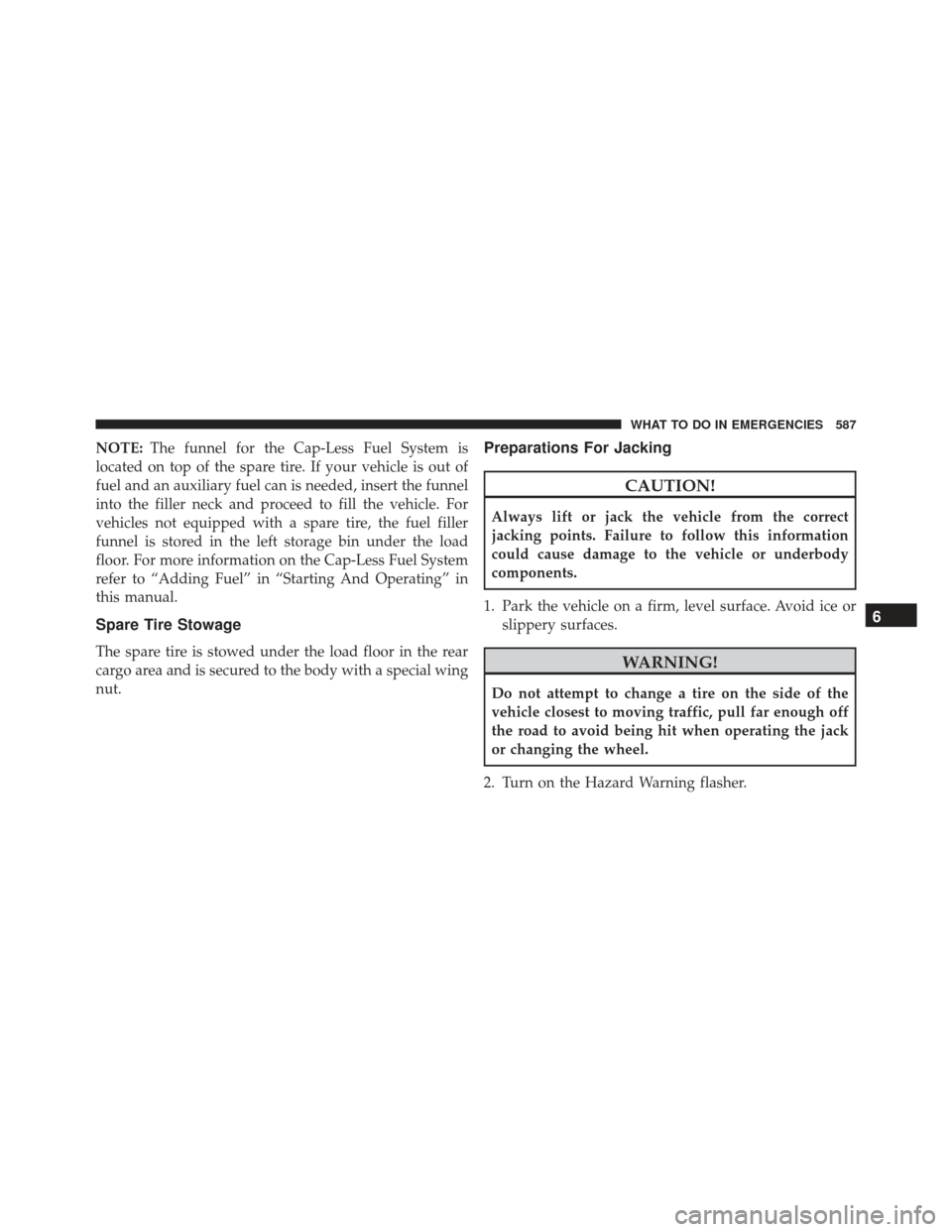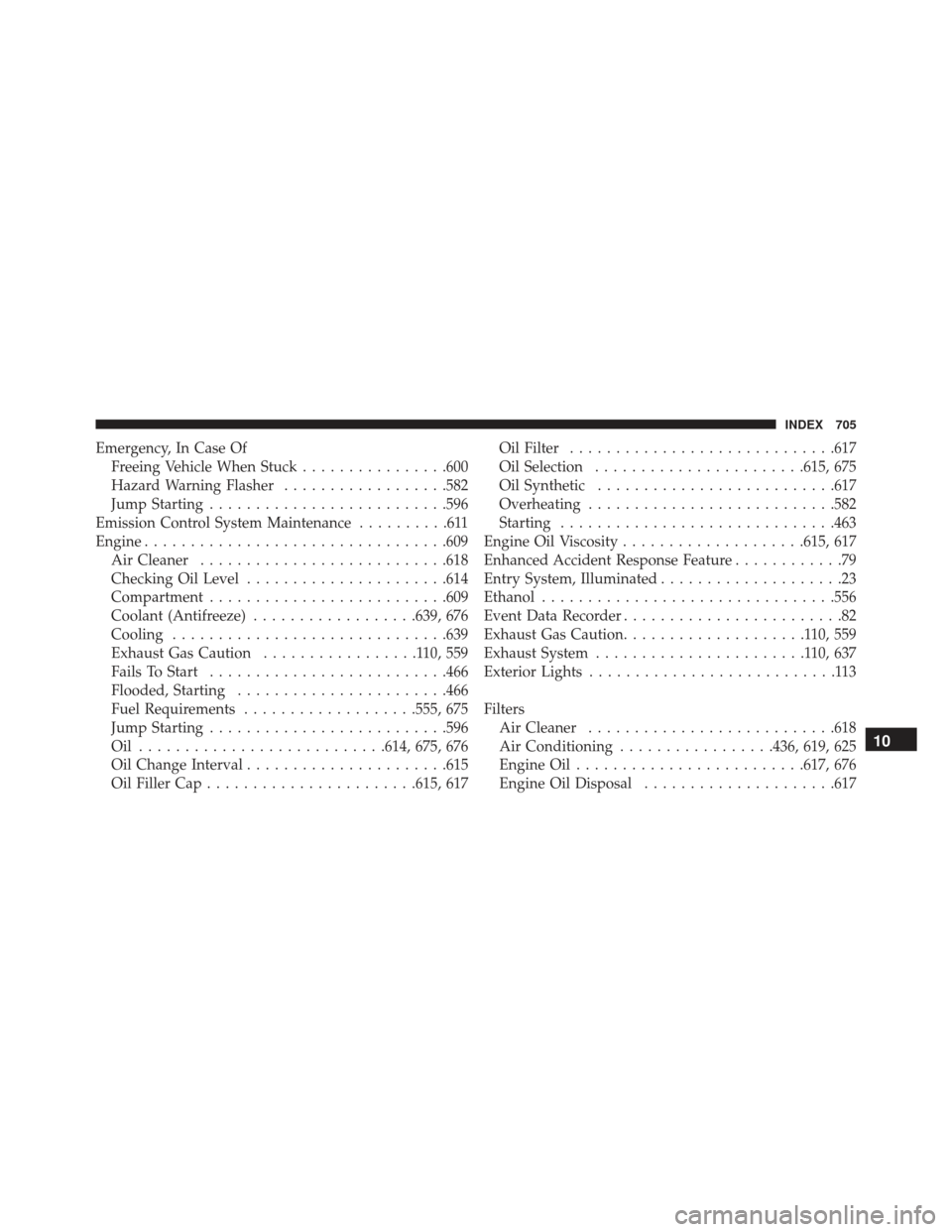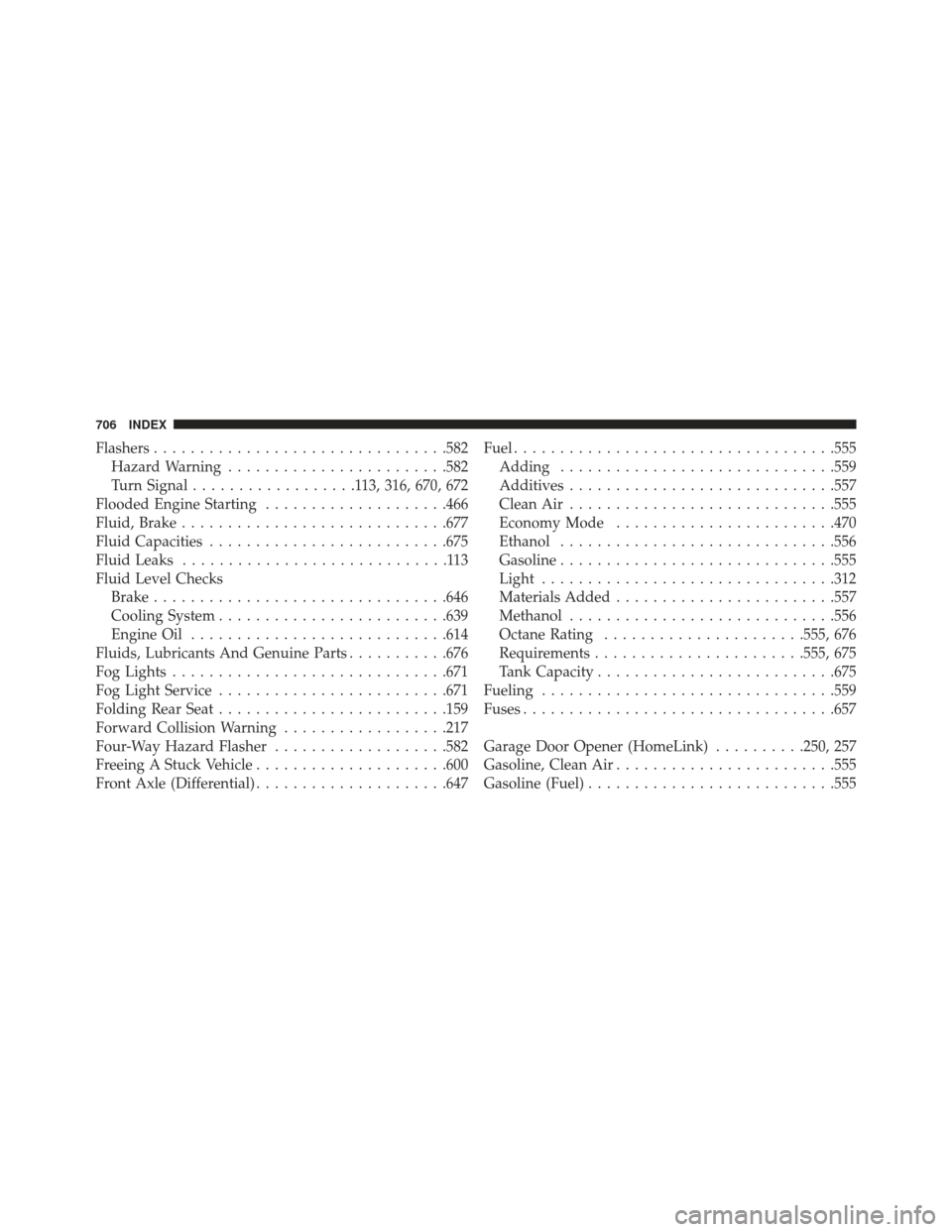Page 307 of 723

Yellow Telltale Indicator Lights
Engine Check/Malfunction Indicator Light (MIL)
Yellow TelltaleLight What It Means
Engine Check/Malfunction Indicator Light (MIL)
The Engine Check/Malfunction Indicator Light (MIL) is a part of an Onboard Diagnostic
System called OBD II that monitors engine and automatic transmission control systems. The
light will illuminate when the ignition is in the ON position before engine start. If the bulb
does not come on when turning the key from OFF to ON/RUN, have the condition checked
promptly.
Certain conditions, such as a loose or missing gas cap, poor quality fuel, etc., may illuminate
the light after engine start. The vehicle should be serviced if the light stays on through sev-
eral typical driving styles. In most situations, the vehicle will drive normally and will not
require towing.
When the engine is running, the MIL may flash to alert serious conditions that could lead to
immediate loss of power or severe catalytic converter damage. The vehicle should be ser-
viced as soon as possible if this occurs.4
UNDERSTANDING YOUR INSTRUMENT PANEL 305
Page 563 of 723

3. There is no fuel filler cap. A flapper door inside thepipe seals the system.
4. Insert the fuel nozzle fully into the filler pipe, the nozzle opens and holds the flapper door while refuel-
ing.
5. Fill the vehicle with fuel, when the fuel nozzle “clicks” or shuts off the fuel tank is full.
6. Wait 5 seconds before removing the fuel nozzle to allow fuel to drain from nozzle.
7. Remove the fuel nozzle and close the fuel door.
Emergency Gas Can Refueling
• Most gas cans will not open the flapper door.
• A funnel is provided to open the flapper door to allow
emergency refueling with a gas can. •
Retrieve funnel from the spare tire storage area.
• Insert funnel into same filler pipe opening as the fuel
nozzle.
• Ensure funnel is inserted fully to hold flapper door
open.
• Pour fuel into funnel opening.
• Remove funnel from filler pipe, clean off prior to
putting back in the spare tire storage area.
CAUTION!
To avoid fuel spillage and overfilling, do not “top
off” the fuel tank after filling.
5
STARTING AND OPERATING 561
Page 565 of 723
NOTE:If the fuel door does not latch after the manual
release cable has been activated, the actuator latch should
be manually returned to the closed position.
VEHICLE LOADING
Certification Label
As required by National Highway Traffic Safety Admin-
istration regulations, your vehicle has a certification label
affixed to the driver’s side door or pillar.
This label contains the month and year of manufacture,
Gross Vehicle Weight Rating (GVWR), Gross Axle Weight
Rating (GAWR) front and rear, and Vehicle Identification
Number (VIN). A Month-Day-Hour (MDH) number is
included on this label and indicates the Month, Day and
Hour of manufacture. The bar code that appears on the
bottom of the label is your VIN.
Gross Vehicle Weight Rating (GVWR)
The GVWR is the total permissible weight of your vehicle
including driver, passengers, vehicle, options and cargo.
The label also specifies maximum capacities of front and
Release Cable
5
STARTING AND OPERATING 563
Page 566 of 723

rear axle systems (GAWR). Total load must be limited so
GVWR and front and rear GAWR are not exceeded.
Payload
The payload of a vehicle is defined as the allowable load
weight a truck can carry, including the weight of the
driver, all passengers, options and cargo.
Gross Axle Weight Rating (GAWR)
The GAWR is the maximum permissible load on the front
and rear axles. The load must be distributed in the cargo
area so that the GAWR of each axle is not exceeded.
Each axle GAWR is determined by the components in the
system with the lowest load carrying capacity (axle,
springs, tires or wheels). Heavier axles or suspension
components sometimes specified by purchasers for in-
creased durability does not necessarily increase the vehi-
cle’s GVWR.
Tire Size
The tire size on the Vehicle Certification Label represents
the actual tire size on your vehicle. Replacement tires
must be equal to the load capacity of this tire size.
Rim Size
This is the rim size that is appropriate for the tire size
listed.
Inflation Pressure
This is the cold tire inflation pressure for your vehicle for
all loading conditions up to full GAWR.
Curb Weight
The curb weight of a vehicle is defined as the total weight
of the vehicle with all fluids, including vehicle fuel, at full
capacity conditions, and with no occupants or cargo
loaded into the vehicle. The front and rear curb weight
564 STARTING AND OPERATING
Page 589 of 723

NOTE:The funnel for the Cap-Less Fuel System is
located on top of the spare tire. If your vehicle is out of
fuel and an auxiliary fuel can is needed, insert the funnel
into the filler neck and proceed to fill the vehicle. For
vehicles not equipped with a spare tire, the fuel filler
funnel is stored in the left storage bin under the load
floor. For more information on the Cap-Less Fuel System
refer to “Adding Fuel” in “Starting And Operating” in
this manual.
Spare Tire Stowage
The spare tire is stowed under the load floor in the rear
cargo area and is secured to the body with a special wing
nut.
Preparations For Jacking
CAUTION!
Always lift or jack the vehicle from the correct
jacking points. Failure to follow this information
could cause damage to the vehicle or underbody
components.
1. Park the vehicle on a firm, level surface. Avoid ice or slippery surfaces.
WARNING!
Do not attempt to change a tire on the side of the
vehicle closest to moving traffic, pull far enough off
the road to avoid being hit when operating the jack
or changing the wheel.
2. Turn on the Hazard Warning flasher.
6
WHAT TO DO IN EMERGENCIES 587
Page 677 of 723
FLUID CAPACITIES
U.S.Metric
Fuel (Approximate) 25 Gallons94.0 Liters
Engine Oil With Filter
6.4 Liter Engine (SAE 0W-40, Synthetic API Certified) 7 Quarts6.6 Liters
Cooling System*
6.4 Liter Engine (MOPAR Antifreeze/Engine Coolant 10 Year/
150,000 Mile Formula that meets the requirements of FCA Material
Standard MS.90032. 16 Quarts
15.5 Liters
* Includes heater and coolant recovery bottle filled to MAX level.
7
MAINTAINING YOUR VEHICLE 675
Page 707 of 723

Emergency, In Case OfFreeing Vehicle When Stuck ................600
Hazard Warning Flasher ..................582
Jump Starting ......................... .596
Emission Control System Maintenance ..........611
Engine ................................ .609
Air Cleaner .......................... .618
Checking Oil Level ..................... .614
Compartment ......................... .609
Coolant (Antifreeze) ..................639, 676
Cooling ............................. .639
Exhaust Gas Caution .................110,559
Fails To Start ......................... .466
Flooded, Starting ...................... .466
Fuel Requirements ...................555, 675
Jump Starting ......................... .596
Oil .......................... .614, 675, 676
Oil Change Interval ..................... .615
Oil Filler Cap ...................... .615, 617Oil Filter
............................ .617
Oil Selection ...................... .615, 675
Oil Synthetic ......................... .617
Overheating .......................... .582
Starting ............................. .463
Engine Oil Viscosity ....................615, 617
Enhanced Accident Response Feature ............79
Entry System, Illuminated ....................23
Ethanol ............................... .556
Event Data Recorder ........................82
Exhaust Gas Caution ....................110,559
Exhaust System .......................110,637
Exterior Lights ...........................113
Filters Air Cleaner .......................... .618
Air Conditioning .................436, 619, 625
Engine Oil ........................ .617, 676
Engine Oil Disposal .....................617
10
INDEX 705
Page 708 of 723

Flashers............................... .582
Hazard Warning ....................... .582
Turn Signal ..................113, 316, 670, 672
Flooded Engine Starting ....................466
Fluid, Brake ............................ .677
Fluid Capacities ......................... .675
Fluid Leaks .............................113
Fluid Level Checks Brake ............................... .646
Cooling System ........................ .639
Engine Oil ........................... .614
Fluids, Lubricants And Genuine Parts ...........676
Fog Lights ............................. .671
Fog Light Service ........................ .671
Folding Rear Seat ........................ .159
Forward Collision Warning ..................217
Four-Way Hazard Flasher ...................582
Freeing A Stuck Vehicle .....................600
Front Axle (Differential) .....................647 Fuel
.................................. .555
Adding ............................. .559
Additives ............................ .557
Clean Air ............................ .555
Economy Mode ....................... .470
Ethanol ............................. .556
Gasoline ............................. .555
Light ............................... .312
Materials Added ....................... .557
Methanol ............................ .556
Octane Rating ..................... .555, 676
Requirements ...................... .555, 675
Tank Capacity ......................... .675
Fueling ............................... .559
Fuses ................................. .657
Garage Door Opener (HomeLink) ..........250, 257
Gasoline,
Clean Air ....................... .555
Gasoline (Fuel) .......................... .555
706 INDEX